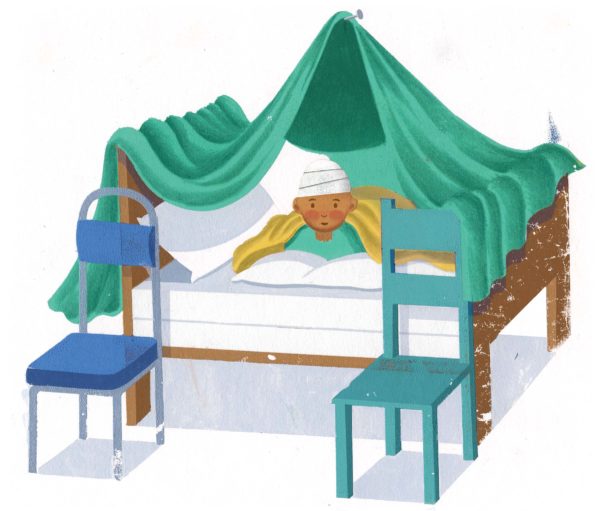Going Home
As difficult as it is to be in the hospital with your child, you may have mixed emotions about going home. Managing pain, assessing wounds and identifying post-operative complications can all seem very scary and overwhelming. This section is designed to give you information to help you go home feeling more secure and confident. It offers you information on home care of a child post-operation, preparing for follow-up appointments, directions for creating a medical profile and where to get medical alert jewelry.

Home care and follow-up
Follow-up Appointment
At the time of discharge, staff will give you a date and time for a follow-up visit, usually one to two weeks after your child’s surgery date. Mark it down on your calendar as soon as you get home. If for some reason you don’t have a follow-up booked, contact your doctor’s office.
You may also be prescribed medication to be used at home. It is a good idea to have it filled at the Rexall Pharmacy that is located on the main level of the hospital. Make sure you have all of your benefit cards with you. Take all prescribed medication as ordered.
Wound Care
Your doctor or nurse practitioner will give you specific instructions about how to care for your child’s surgical wound. We have given some general wound care information below.
A little swelling and pinkness around the incision is a normal part of healing. Ask your nurse or doctor what you should look for as signs of poor healing or infection. Some key signs are increasing swelling, redness, pus, fluid or leakage, or a wider or splitting wound.
There may or may not be a dressing on the wound. Do not apply a dressing to a wound unless your doctor has advised you to.
If there are steri-strips (small tapes) on the incision, do not pick at them or pull them off. They will naturally fall off in one to two weeks. There may be some dissolvable blue sutures (stitches) in the incision. Never pull, cut or pick at them as it may take several weeks to dissolve.
Medical staff will tell you when your child can resume showering. Most children should not bathe or swim for at least six weeks until the incision is fully closed and healed. This is important for infection control and wound healing.
IMPORTANT!
For serious concerns or emergencies, visit the Stollery Children’s Hospital Emergency Department,
located at 8440-112 Street.
- If you are out of town, proceed to your local emergency room.
- If the physician believes your child needs to be assessed by neurosurgery, they will transfer your child to the Stollery.
- It’s safer to have them accompanied by a medical team in case the condition takes a turn for the worse.
If your child’s condition is life threatening, call 911.
CALL THE NEUROSURGEON OR NURSE PRACTITIONER IN CASES OF:
- Fever of 38 C or over
(37 C is normal) - Leakage of fluid from incision
- Redness, swelling or pus around or from incision
- Vomiting, especially if persistent, severe and not related to another illness
- Headaches, if they are persistent with no relief and associated with vomiting or if they occur at the same time every day
- Any pain not relieved with Tylenol or Advil
Temperature and Fevers
After your child’s operation it is important to monitor for a fever. Our normal body temperature is about 37 C or 98 F. Our body temperature fluctuates throughout the day and tends to be coolest in the early morning and highest in evening between 6 p.m. and 8 p.m. If your child’s temperature is greater than 38 C or 100 F it means they have a fever.
A few things to consider when taking your child’s temperature are proper placement of the thermometer, in the ear, under the tongue or armpit. Also take into consideration if your child is overdressed or under-dressed, if they are laying on the ear being tested, or if they just ate a popsicle or hot bowl of soup. These things will alter your reading.
| FAHRENHEIT | CELSIUS | |
|---|---|---|
| 104.0 | 40 | |
| 103.1 | 39.5 | |
| 102.2 | 39 | |
| 101.3 | 38.5 | |
| 100.4 | 38 | |
| 98.6 | 37 | Normal |
| 96.8 | 36 | |
| 95.0 | 35 |
TIP: For small children, taking temperature in armpit is usually the easiest and most accurate.

